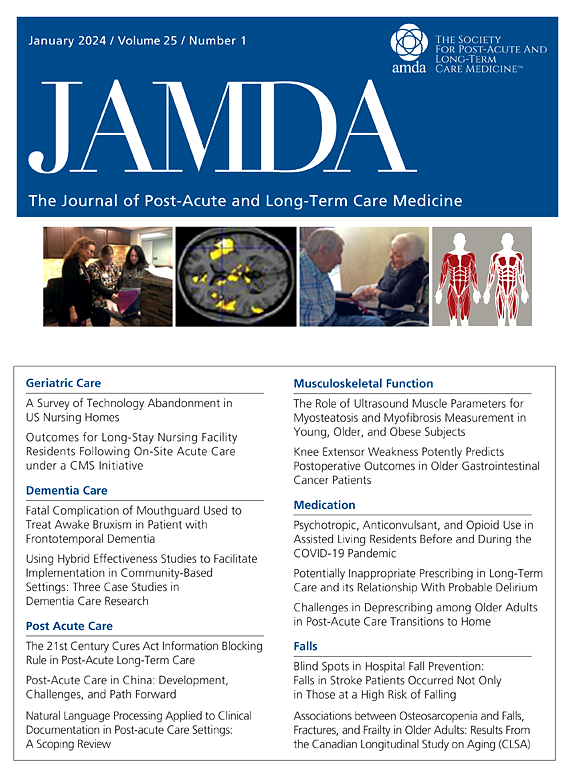长期护理医院的地点中立支付是否降低了按时出院的财务激励?
IF 3.8
2区 医学
Q2 GERIATRICS & GERONTOLOGY
Journal of the American Medical Directors Association
Pub Date : 2025-06-11
DOI:10.1016/j.jamda.2025.105689
引用次数: 0
摘要
目的:从历史上看,按服务收费的医疗保险报销长期护理医院(LTCH)住院费用是一次性支付的,在诊断特异性短期住院异常值(SSO)阈值日之前出院的费用大幅减少,导致阈值日出院人数大幅增加。本研究的目的是检验ltch是否在混合站点中立支付情况下与标准支付情况下在SSO阈值处相似的时间放电。设计:横断面。背景和参与者:医疗保险受益人队列。方法:我们使用2017财政年度全国100% LTCH医疗保险提供者分析和审查有限数据集,并使用调整患者人口统计学和病例组合的多项模型来利用先前ICU天数的差异。我们只包括那些付款状态完全由之前ICU天数决定的住宿。我们的主要结果是SSO阈值当天的出院情况。暴露是在之前的急性护理医院重症监护病房≥3天的指标变量,其中“是”等同于标准支付,“否”是混合地点中性病例。结果:在10910例LTCH出院病例中(48%的病例年龄在65-74岁之间,52%为女性,25%为非白人,24%为混合站点中立病例),我们发现,尽管付款增加减少了约50%,但在SSO阈值日与前一天的调整后出院概率峰值在混合站点中立病例(20%对2%)和标准支付病例(16%对1%)相似,调整后差异为-3% (95% CI, -5%至2%)。结论和影响:尽管支付增加了50%,但在SSO阈值上的无根据的放电峰值仍然存在,这对于寻求避免激励以战略性地选择放电时间的政策制定者和付款人来说是一个至关重要的见解。长期住院治疗的费用应报销,而不应根据住院时间的长短增加有意义的费用。本文章由计算机程序翻译,如有差异,请以英文原文为准。
Did Site-Neutral Payment for Long-Term Care Hospitals Reduce Financial Incentives to Time Discharge?
Objectives
Historically, fee-for-service Medicare reimbursed long-term care hospital (LTCH) stays as a lump-sum payment, which was substantially reduced for discharges before the diagnosis-specific short-stay outlier (SSO) threshold day, leading to large spikes in discharges on the threshold day. The objective of this study was to examine if LTCHs similarly time discharge at the SSO threshold for blended site-neutral payment cases compared with standard payment cases.
Design
Cross sectional.
Setting and Participants
Cohort of Medicare beneficiaries.
Methods
We used the national 100% LTCH Medicare Provider Analysis and Review Limited Data Set for fiscal year 2017 and exploited differences in prior ICU days using a multinomial model adjusting for patient demographics and case-mix. We only included stays where payment status was solely determined by prior ICU days. Our primary outcome was the discharge on the SSO threshold day. The exposure was an indicator variable for ≥3 intensive care unit days in the preceding acute care hospital, where yes equated to standard payment and no was a blended site-neutral case.
Results
Among 10,910 LTCH discharges (48% of cases were aged 65-74 years, 52% were female, 25% were non-white, 24% were blended site-neutral cases), we found that despite an approximately 50% reduction in payment increase, the spike in the adjusted probability of discharge on the SSO threshold day vs the day before was similar for blended site-neutral (20% vs 2%) and standard payment cases (16% vs 1%), with an adjusted difference of −3% (95% CI, −5% to 2%).
Conclusions and Implications
Unwarranted spikes in discharge on the SSO threshold persisted despite a 50% reduction in the payment increase, a crucial insight for policymakers and payers who seek to avoid incentives to strategically time discharges. LTCH stays should be reimbursed without meaningful payment increases based on length of stay thresholds.
求助全文
通过发布文献求助,成功后即可免费获取论文全文。
去求助
来源期刊
CiteScore
11.10
自引率
6.60%
发文量
472
审稿时长
44 days
期刊介绍:
JAMDA, the official journal of AMDA - The Society for Post-Acute and Long-Term Care Medicine, is a leading peer-reviewed publication that offers practical information and research geared towards healthcare professionals in the post-acute and long-term care fields. It is also a valuable resource for policy-makers, organizational leaders, educators, and advocates.
The journal provides essential information for various healthcare professionals such as medical directors, attending physicians, nurses, consultant pharmacists, geriatric psychiatrists, nurse practitioners, physician assistants, physical and occupational therapists, social workers, and others involved in providing, overseeing, and promoting quality

 求助内容:
求助内容: 应助结果提醒方式:
应助结果提醒方式:


